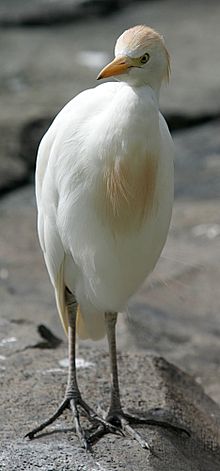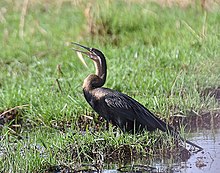| http://www.biodiversityexplorer.org/birds/ ciconiidae/anastomus_lamelligerus.htm |
African Openbill
This
species can be found in freshwater wetlands such as swamps, marshes, rice
fields, the backwaters of lakes or rivers, and flood plains. It can also be
found in areas such as grassland or moist savanna and even forest clearings on
occasion. This species diet mainly consists of snails, freshwater mussels,
frogs, crabs, worms, fish, and insects.
.jpg/220px-Flickr_-_Rainbirder_-_Long-tailed_Cormorant_(Phalacrocorax_africanus).jpg) |
| http://en.wikipedia.org/wiki/Reed_Cormorant |
Long-tailed Cormorant
The Long-tailed Cormorant can be found in areas where there are sheltered waters with trees, vegetation, and sloping shores. This species also likes floodwaters and freshwater habitats excluding fast-flowing streams. They like slow flowing rivers, creeks, swamps, lagoons, ponds, lakes, and thickets. When it comes to diet, the Long-tailed Cormorant mainly eats fish but also will eat frogs, aquatic insects, mollusks, crustaceans, and even sometimes, small birds.
African Darter
The
African Darter can be found in shallow, inland freshwater, slow flowing rivers,
and lakes. It can also sometimes be found in reservoirs, swamps, and streams.
This species usually avoids marine habitats but rarely can be found in coastal
lagoons and shallow tidal inlets. The African Darter needs trees and bushes for
roosting and has a diet that mainly consists of fish but will also eat aquatic
insects, water snakes, crustaceans, amphibians, and mollusks.
Cattle Egret
 |
| http://en.wikipedia.org/wiki/Cattle_egret |
The
Cattle Egret is found in open grassy areas. These areas include open savanna
grassland, meadows, dry fields, livestock pastures, flood plains, rice fields,
freshwater swamps, shallow marshes, and even ponds, small rivers, and streams.
This species may inhabit marine or forested areas but this is rather rare. The
Cattle Egret’s diet mainly consists of insects. This includes beetles, locusts,
dragonflies, grasshoppers, and centipedes. However, frogs, mollusks, fish,
worms, spiders, lizards, small birds, rodents, and crustaceans are also eaten.

No comments:
Post a Comment